Discovering Parma
I want to tell you about a city known worldwide for its gastronomic products, but at the same time an Italian art city with a rich history and unique treasures, nestled in the placid Emilian plain on the banks of the river of the same name: Parma.
It was a very important medieval fortified center, the heart of the Duchy of Parma. It passed from the Visconti, to the Este, to the Sforza. For two centuries (1545 to 1731), however, it was the Farnese seigniory that ruled the city (making it shine and enriching it with sumptuous palaces), succeeded by the Bourbons until the advent of the Austrians.
Today we cannot fully grasp what the grandeur of Ottavio Farnese’s design for his Palazzo della Pilotta, unfinished in its original grandeur and severely mutilated during the bombings of World War II, must have been. The palace, which began as a place of lozio, was in fact named after the game of pelota that was customary to take place in one of its courtyards. A long arm of the building, the runner, joined the river-facing rocchetta to the older Ducal Palace (no longer extant). Courtyards, rooms, stables and additional wings completed the palace complex.
Obviously, this residence was not enough for the Farnese family: for this reason they chose as an additional residence the cooler and quieter arrangement of the Palazzo Giardino, now more commonly known as the Ducal Palace surrounded by the lush Ducal Park on the opposite bank of the Parma River. It was considered the country residence, built to the design of Vignola, chronologically before the Pilotta Palace. It currently appears with its typical Parma yellow color, as it was rearranged in the 1700s by the French architect Petitot.
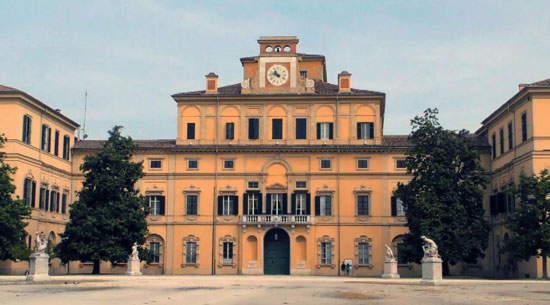 |
| The Garden Palace |
While the latter today is the headquarters of the Carabinieri (and perhaps someone remembers it as the protagonist of the TV drama RIS), the Pilotta on the other hand is currently managed by the Soprintendenza, which takes care of the National Gallery inside it, occupying a large wing of the Corte del Guazzatoio. The Bodonian Museum, dedicated to printing, the Archaeological Museum and the Palatine Library also find accommodation inside.
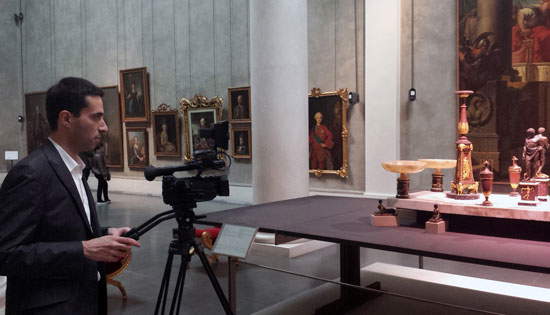 |
| Fabrizio at the National Gallery of Parma, in front of Damià Campeny’s panel triumph, which we discussed in this article |
Surely the heart of the complex, however, is the 17th-century Teatro Farnese, one of the cornerstones of the history of the evolution of theater in Italy (to which I will soon devote a special tip of Pronti Partenza Via). The wooden theater, unlike its earlier models, has a longitudinally elongated cavea, which gave it great spatiality and the possibility of using the stalls, as was the case in Roman amphitheaters, to stage naval combat. Keep in mind that this theater stands on the second floor of the palace, under which there are large porticoed vaults that have small holes from which lacqua used to recreate the flooding of the stalls was discharged.
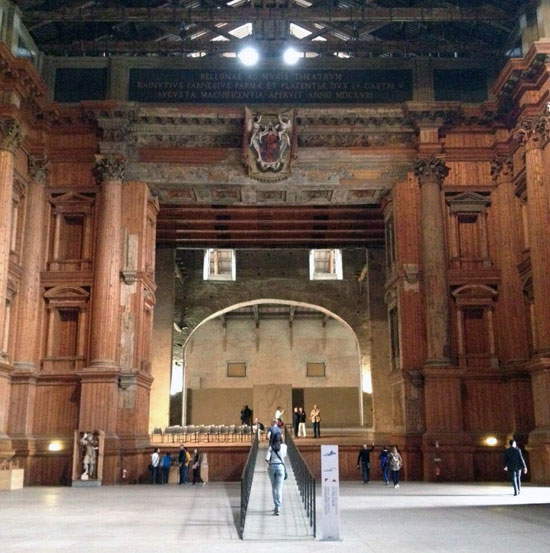 |
| The stage of the Teatro Farnese |
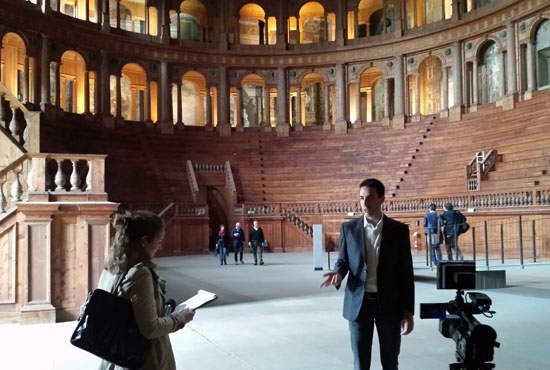 |
| Fabrizio at the Teatro Farnese |
The entire structure of the tiered cavea, modeled after the Teatro Olimpico in Vicenza and the one in Sabbioneta, is made of wood and is no longer usable today for safety reasons. The stage machinery is also, of course, all made of wood, clearly visible since it is not covered by curtains and curtain; the stage itself is walkable and is part of the National Gallery’s tour route. Unfortunately, today’s visitor will never be able to appreciate what this architectural-theatrical marvel originally was, as it was destroyed by a bomb that ripped it completely apart. It was indeed rebuilt, minutely following the original designs of theAleotti, but the paintings, stucco and all the decoration that covered the wooden structure were lost forever.
Staying on the theatrical theme, today Parma is also known for its all-Italian opera house, the 19th-century Teatro Regio, built at the behest of Marie Louise of Austria by the architect Bettòli. Opera began to spread in Parma in 1628 (just to inaugurate the Teatro Farnese) and soon succeeded in winning over the general public thanks in part to such beloved composers as Giuseppe Verdi, who was born in Busseto, a few kilometers from Parma. The city has hosted the annual Verdi festival since 2007 and is constantly dedicated to music with a series of events, manifestations and facilities specially built for music teaching, which are flanked by halls and auditoriums including one dedicated to Parma’s Arturo Toscanini; therefore, Parma can be for all intents and purposes considered one of the capitals of music in Italy.
Alongside music, art also plays a prominent role in the city beginning with the sculptor Benedetto Antélami (and not Antelà mi as incorrectly pronounced in our video): some of his works can be found inside the Duomo and in the beautiful Romanesque-Gothic Baptistery. Painting is worthily represented by Correggio (author of the frescoes of the cathedral dome and St. John the Evangelist) and Parmigianino (some of his canvases are on display at the National Gallery).
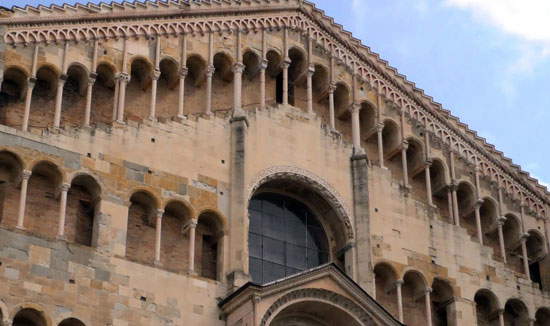 |
| Façade of Parma Cathedral |
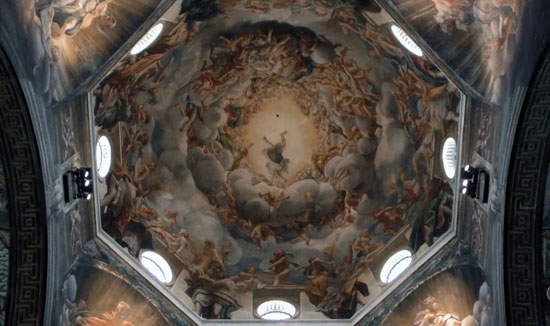 |
| The dome of Parma Cathedral with the Assumption of the Virgin frescoed by Correggio |
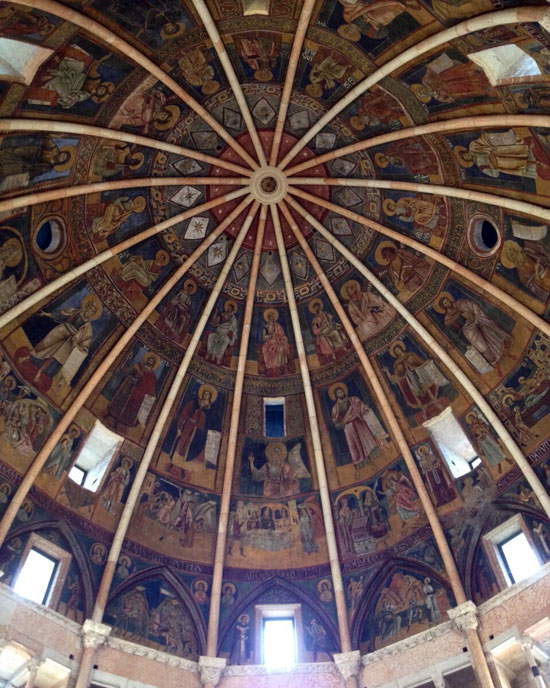 |
| The paintings decorating the dome of the Baptistery of Parma |
Two other unmissable gems in the city are the ancient Spezieria Benedettina, once part of the monastic complex of San Giovanni, now a valuable example of a 16th-century pharmacy with original wooden furnishings, vases and stills. The other gem is the Camera del Correggio, a room that was part of the Benedictine monastery of the Sisters of St. Paul, whose umbrella vault is richly and skillfully frescoed by the then young and promising Antonio Allegri da Correggio.
There is no need for me to add more about the many gastronomic products that make Parma and its territory truly rich and enviable. So there are no more excuses to stay at home, get ready to set out to discover Parma, you will find history, music, art and many good reasons to tantalize yourself.
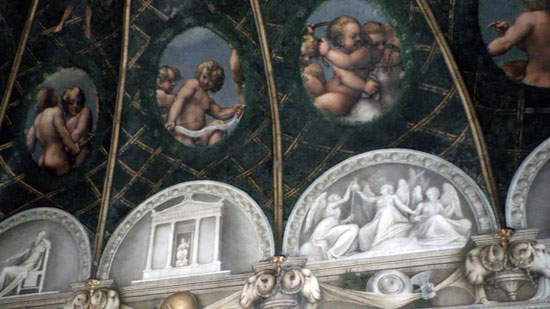 |
| Frescoes in the Camera del Correggio |
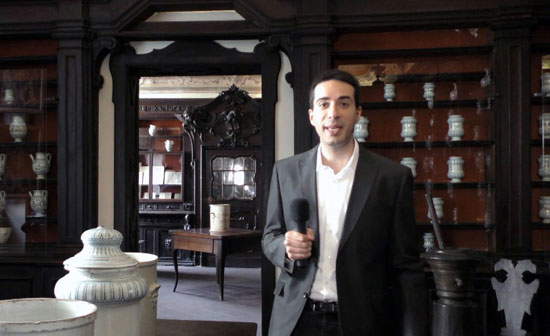 |
| Fabrizio in the Spezieria Benedettina |
Warning: the translation into English of the original Italian article was created using automatic tools. We undertake to review all articles, but we do not guarantee the total absence of inaccuracies in the translation due to the program. You can find the original by clicking on the ITA button. If you find any mistake,please contact us.





























